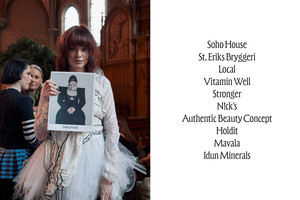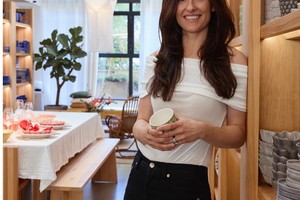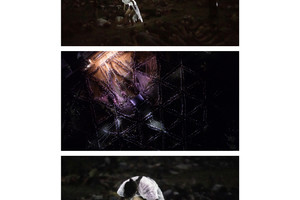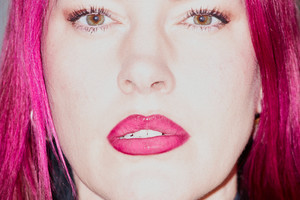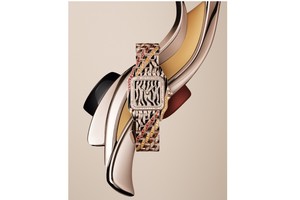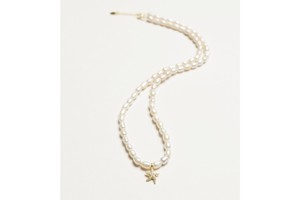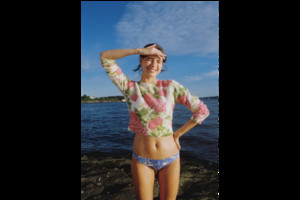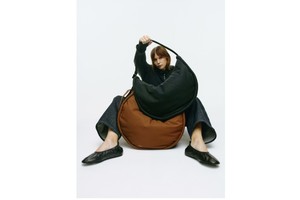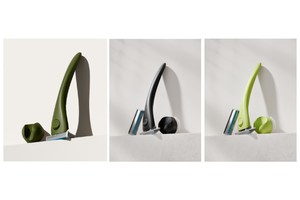For Kartell, innovation isn’t just a strategy, it’s genetic. As the granddaughter of the brand’s founder, Lorenza Luti, Marketing and Retail Director at Kartell, has spent a lifetime watching plastic transcend its industrial roots to become sculptural, sustainable, and even visual poetry. Today, she steers the iconic Italian design house into the future, with every piece produced by Kartell telling a story.
In this interview, Luti reveals how Kartell balances heritage with disruption, why sustainability demands ‘revolutionary materials, not just green gestures,’ and how a family business thrives when it treats design as ‘a spark, not a formula.’
Natalia Muntean: How do you see Kartell evolving over the next decade, and what role do you envision yourself playing in that evolution?
Lorenza Luti: Our creativity and purpose of always innovating will not stop in the future. Kartell has always worked, above all, in the logic of innovation, carrying on simultaneously creativity with impossible challenges never realised before. We will continue strengthening the brand through the expansion and diversification of the sales network with a very specific global retail policy that guarantees strong brand recognition. Today, as in the future, Kartell aims to be not just a furniture product but a real lifestyle brand. This is the path that was traced first by my grandfather, followed by my father up to now, and certainly, my brother Federico and I will continue on this path, carrying forward this legacy.
NM: How do you honour Kartell's legacy while pushing for innovation? What challenges have you faced as a leader in a family-owned business, and who has inspired your leadership style?
LL: Being part of a family business like Kartell is wonderful, even if it requires a lot of commitment because the private and professional spheres inevitably overlap. But it is rewarding to be part of a great story, one that has been going on since the generation of my grandparents and continues today with mine and my brother's commitment, alongside my father. Since I was a child, Kartell has been part of my life. I carry within me the passion and commitment that I have seen in my father when he follows the birth of every single project and finds the right idea to transform a creative intuition into a market success. Nohing stimulates me and gives me more satisfaction than attending meetings between him and the designers. It is a back and forth of ideas, a continuous exchange of working hypotheses and new discoveries, always going further.
NM: What has been the most rewarding aspect of your career at Kartell so far, and what lessons have you learned along the way?
LL: There is no design without emotion and this has been our inspiration. A design piece must tell a story, going beyond the product itself. I firmly believe that this is the direction in which we need to go: to excite by creating not a series of objects but a transversal and versatile lifestyle. A complete proposal that knows how to arouse something, in which the products enter into dialogue with each other and in relation to the living spaces, creating personal solutions. It is the vision of design that is always on the move, in which a style becomes strong and recognisable precisely because it can highlight the living room, the different contexts and cultures with which it is mixed.
NM: Can you elaborate on some of the key initiatives Kartell has undertaken to become more sustainable? How do you balance the need for innovative design with the increasing demand for sustainable products?
LL: Our commitment to sustainability and environmental protection has always been a priority at Kartell. The passion for excellence, that has guided Kartell's development since its origins, has led us to focus on environmental responsibility and attention to good sustainability practices. For us, each item we create is a timeless product, developed with respect for the environment and designed to occupy museum spaces and collectors' assets at the end of its function. Kartell's commitment to implementing and increasingly improving the environmental management system is guaranteed by adherence to International certification protocols.
We have always been looking for new materials that can meet the characteristics and quality standards that have distinguished Kartell since the beginning. Today we work with many sustainable materials such as recycled material, bio, wood, green polycarbonate and recycled PMMA, as well as using materials such as glass and metal, which by their nature are also recyclable. We have many projects in different directions, and we are carrying out continuous research into materials and technologies.
All the packaging is 100% recyclable and the entire production process chain sees Kartell committed to safeguarding the environment and respecting sustainability protocols. It is not simply a matter of creating a product that seems green, but of generating an industrial strategy that involves the entire production process, from the economic plan to marketing, from communication actions to the sales network.
NM: Can you discuss any recent innovations in materials or manufacturing processes that Kartell has adopted to stay ahead in the industry?
LL: Industrial production is a fundamental element of Kartell's DNA, and this is perfectly reflected in all our collections. The company has always been able to combine technological innovation with refined aesthetics, managing to blend craftsmanship and industrial design in a unique way. This approach has made Kartell a point of reference in the sector, where innovation is never an end in itself, but is always accompanied by a strong sense of aesthetics. The ability to use advanced technologies has allowed us to obtain sophisticated shapes and precision details, making each product a functional work of art. Our catalogue is the result of this fusion between high technology and design, which allows us to maintain high quality and innovation, always guaranteeing modern and long-lasting solutions. The continuous search for cutting-edge materials and production processes is what makes Kartell a distinctive brand, capable of responding to the challenges of the present without ever forgetting its roots.
NM: What is Kartell's design philosophy, and how do you ensure that it remains relevant in a rapidly changing market?
LL: For Kartell, innovation is a fundamental value, a driving force that guides every phase of research and development. The company works in every direction, from re-editions in new colours, to experiments that combine new materials and shapes. This approach allows even historical projects to be brought to life and become current, as is the case of the Audrey chair, which in 2025 undergoes a chromatic transformation. But innovation does not stop at the aesthetic surface: a clear example is the Belvedere chair, which combines Kartell's typical plastic material with natural straw, creating a unique fusion of tradition and technology. The aim is always to respect the soul of original projects, such as those by Piero Lissoni, but at the same time to adapt them to contemporary needs and sensibilities. This way, Kartell manages to maintain a balance between respect for the past and a drive towards the future, offering products that are both iconic and innovative, perfectly in tune with the trends and challenges of the present.
NM: How do you select designers to collaborate with, and what do these collaborations bring to the brand?
LL: Kartell has a rich history of collaborating with renowned international designers, constantly seeking to explore new territories. We are open to being influenced by various production sectors, art, and the social world, while remaining committed to following our unique path. When seeking collaborations, we prioritise individuals who can help us create innovative designs. Our focus is not on following trends or adhering to a specific style, but rather on uncovering new avenues of creativity while upholding our identity grounded in quality, innovation, and industrial design. As a result, we have been able to create products that have become timeless icons, some of which continue to adorn homes worldwide even after more than fifty years. I like working with all the designers who collaborate with Kartell because each one brings their own vision and creativity, always from an industrial production perspective. I find it stimulating to see how, by working together, innovative and original ideas come to life. Each collaboration is an opportunity to explore new perspectives and push the boundaries of design, always maintaining the excellence and quality that characterise Kartell. It is a dynamic and enriching process, which inspires and motivates me every day.
NM: What do you think will be the most significant shifts in consumer behaviour over the next few years, and how is Kartell preparing for them?
LL: Our strategy is based on online and offline multi-channel. Today, in its expansion process, stores are becoming increasingly larger, so we had to rethink our spaces both to create a story capable of making our bestsellers communicate with the latest product news but also to convey Kartell's renewed ability to offer total living proposals in which sofas are set with armchairs, rugs, side tables and lights as well as tables and chairs, thanks to the expansion of the range and the inclusion of products and product families that allow us to represent an overall vision and also satisfy a very broad market demand. This, without forgetting our vertical display, which is becoming even more elegant. E-commerce is the other Kartell distribution channel, together with Retail, which for us remains our core business. In 2014, we were the first in the furniture sector to open a direct e-commerce that we have continued to develop and enrich, becoming a real relationship platform with our customers. The site is not only a commercial digital showcase but is a global platform for corporate storytelling. Furthermore, we are increasingly working towards harmonising the showcase campaign, which is now the same for both the digital and traditional retail parts. This is immediately visible starting from the home page, where there are not only showcase launches but also editorial or cultural content that give a well-rounded vision of our brand.
NM: What emerging trends in the furniture and design industry are you most excited about, and how is Kartell positioning itself to capitalise on these trends?
LL: Our philosophy is to create emotion through our products to achieve what we call the Kartell lifestyle or the possibility of combining our products in different contexts and with any style while maintaining a very precise identity that makes them immediately recognisable without following specific trends: this has allowed us over the years, to range across different sectors and in all countries of the world without ever sacrificing the DNA of the brand. Thanks to our rich catalogue, we have the possibility of being transversal to tastes and cultures, satisfying the tastes of our customers at all latitudes but always respecting our DNA and our lifestyle
NM: How does Kartell differentiate itself from competitors in a crowded market, and what do you see as the brand's unique value proposition?
LL: Innovation is certainly the driving force behind Kartell's creativity and success. The company works to create projects that technology has never allowed before, thanks to the use of innovative materials, borrowed from other sectors, and unique moulding techniques that allow it to create products that are unrivalled in size and shape. There have been many product and process innovations, some of which are revolutionary, in the history of the brand, and Kartell has shown that it knows how to shapeshift, anticipating changes in taste and needs of an ever-evolving international market and customer without distorting its DNA. Kartell is a creative laboratory of ideas that allows us to work in parallel on design solutions that combine innovation and industrial production. Certainly, to create materials that are not only sustainable but also revolutionary, there are long years of research into the process and the product. Not only is a study done on the material, but also on the mould that must be adapted to materials that have technical and structural characteristics different from traditional plastic material.
NM: How does Kartell ensure its designs resonate with a global audience while maintaining its Italian heritage?
LL: Kartell has a strong international presence, and 80% of our business comes from foreign markets. This is a result that makes us very proud, because it demonstrates the ability of our brand to speak to a global audience, without ever losing our Italian identity. Quality, design and innovation are values that cross borders and allow us to be competitive in every corner of the world. Europe is certainly the most important market, and in particular, France is our second market after Italy. The most important markets for Kartell are those outside Europe: North America, the Middle East, and Asia, in particular the United States and Japan. We are exploring new opportunities in India and North and South Africa, but every market offers us new challenges, but also incredible growth opportunities.
NM: If you could give one piece of advice to aspiring leaders in the design or retail industry, what would it be?
LL: Stay curious and open to new experiences. Embrace change and challenges as opportunities for growth, and don't be afraid to take risks. Building a diverse set of skills and perspectives will serve you well in navigating the ever-evolving landscape of your career and personal development.







